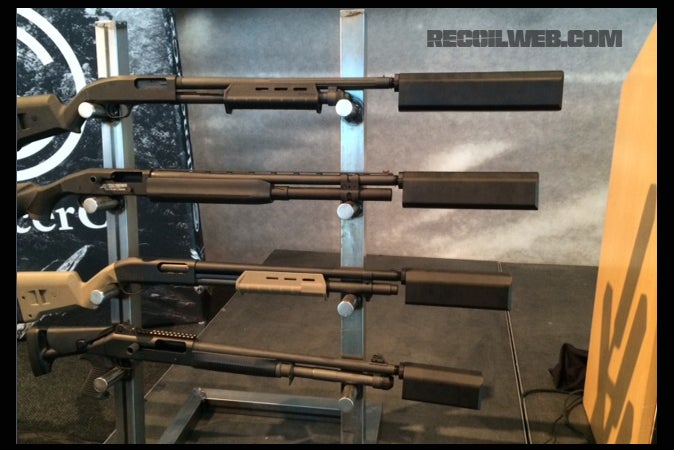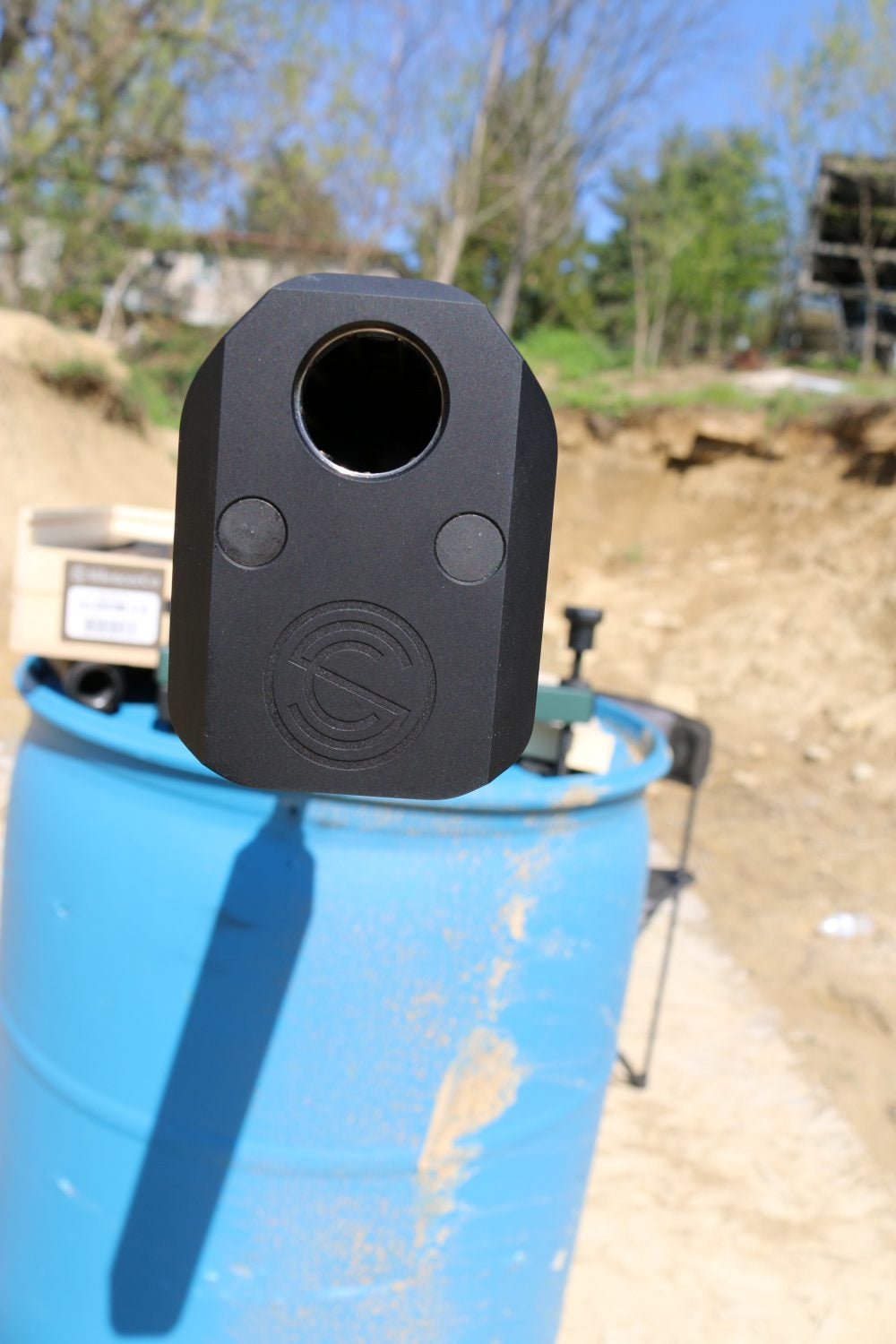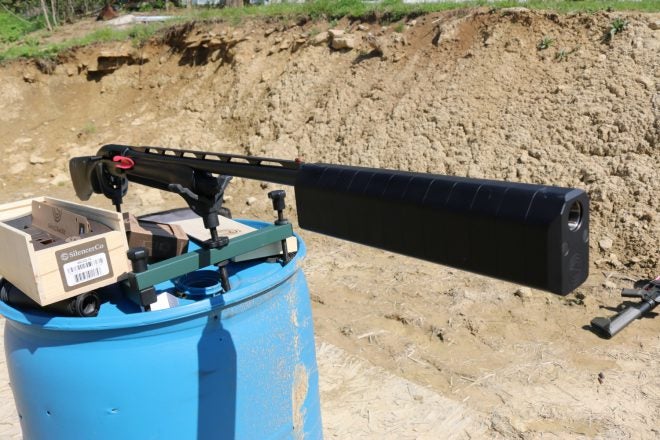While suppressed shotguns have been around for quite a while, the first ideas coming quickly after Maxim’s patents, making a commercially successful one has been the trick that no one had yet mastered, until SilencerCo applied their brain housing groups to the idea.
The challenge with a shotgun suppressor is the huge variety of loads that can be used with them. From 8 sized bird-shot to magnum double-aught, each has significantly different behavior with the shot and how it passes through the bore. Conventional baffled suppressors inevitable have a baffle strike from awry shot. As such, the typical shotgun suppressor has typically be an “over the barrel type” with a myriad of small holes drilled through the gun at various points keeping the choked muzzle architecture.

While this type of shotgun suppressor works, the key to true suppression is the flow of gasses and being to exhaust their energy efficiently into expansion chambers arresting their flow and keeping their pressure wave from imparting energy to the air. So, to create a viable suppressor, a company had to create something that accounts for the plethora of shot, actually suppresses, and interfaces with the huge variety of guns in existence.
Enter The Salvo 12
Announced in mid 2014 and shipped that Fall, the SilencerCo Salvo 12 has been that commercial success by solving those three issues in novel ways.

First, compatibility. As discussed earlier, suppressors for shotguns were typically over-the-barrel types which limited them to single types of guns if not individual firearms only. To solve this, SilencerCo opted to interface with the guns via the choke tube, which allows SilencerCo to create a single interface for the suppressor but on the flip side means that SilencerCo has to manufacture quite a few styles and types of chokes. Either way, its far easier than making so many unique shotgun adapters.
Second and third are solved by a single innovation, the use of rails inside the suppressor. Rather than drill out a tube, the Salvo 12 makes one by using rods arranged around the bore and held in place by the suppressor baffles themselves. This creates are more surface area than drill a bore and keeps the shot contained post choke which should, at least in theory condense the shot for the distance until it exits the bore.

At introduction chokes were only available for Remington 870 shotguns and Benelli’s, but the offerings have expanded markedly since. As of this writing, the Salvo 12 is compatible with the following choke systems:
- Saiga/VEPR
- Remington
- Remington Pro-Bore
- Mossberg 500
- Benelli Crio / Crio-Plus
- Benelli Mobile
- Beretta Optima HP
- Browning Invector
- Keltec KSG
For most systems, a “Choke Kit” is available featuring Improved Modified, Modified, and Full chokes but individual chokes at Improved Cylinder can also be purchased. All combined this allows the Salvo 12 to be compatible with nearly all shotguns and shot shells (which must be wadded).
Taking it a step further, SilencerCo made the suppressor modular by using different sets lengths of rails to add or remove baffle sets, allowing the user to tailor the suppressor to their intended usage. This is accomplished by having the main interface section of the Salvo 12 serve as the legal “suppressor”, which allows the user to disassemble to clean, much like a 22 LR suppressor.
Via three accessory rod kits, the suppressor can be reduced from its standard 12″ configuration to 10″, 8″, and 6″, respectively. At full length using a 18″ barrel, the suppressor is rated for about 132 decibels (dB) at the ear. Moving down is about 134 dB for the 10″, 137 dB (still hearing “safe”) for the 8″, and a quick rise to 140.6 dB at the shortest 6″ configuration (just above the 140 dB “safe” levels). Longer barrels tend to suppress better and shorter barrels tend to suppress worse due to the higher pressures provided to the can.

Photo courtesy of Recoil, who was able to capture the various lengths of the Salvo 12 in one shot.
Capitol Armory has a great testing video on the various dB ratings of the shotgun under scientific conditions and SilencerShop has their own dB testing.
Construction is of stainless and aluminum, forgoing the common SilencerCo inclusion of more advanced materials in pursuit of weight reduction. Weight at the full 12″ configuration is 34.5 ounces, or a bit over 2 lbs. The oblong shape is about 3″ tall by 2 1/4″ wide. The entire suppressor is anodized or otherwise treated to black.
Opening and Installing the Salvo 12
Author’s Note: For testing, SilencerCo sent a Salvo 12, Choke Kit, and rod kit for the can. The testing platform was a Beretta 1301 competition with a 23″ barrel using the Optima HP choke style.
In a break from SilencerCo’s traditional (and excellent) packaging, the Salvo 12 steps it up a notch shipped in a custom wooden box with the logo burned to the cover. Sliding the cover off reveals the Salvo 12 in custom hard-foam, which takes up nearly the whole box. Under the Salvo 12 is the manual, the “Saker Tool” and a bag for storing the can in case the wooden box goes out of style.

The suppressor has no provision for shotguns that have ammo tubes extending past the muzzle, so I was forced to remove the extended tube on the Beretta commonly used for competition. With it removed, installing the Salvo 12 was easy to do, of which I was able to do it “in the field” at the range with no vices or clamps.

First, the standard choke tube must be removed from the shotgun and the SilencerCo Salvo 12 choke adapter must be threaded in. Its common to have “gunk” in your shotgun barrel and threads of which the SilencerCo tool interfaces directly with cuts in the Salvo 12 choke adapter to ensure the choke tube maximizes its interface with barrel. Once the choke tube adapter is screwed in, the Salvo 12 threads directly onto the adapter until threaded as far as it can go and aligned vertically with the bore at which point the spanner wrench is used to tighten the locking collar.

Following the instructions, the Salvo 12 was rigid with the barrel of the Beretta. No wobble, play, or indication that that the suppressor was not firmly attached was visible or tactile. Picking the shotgun up, the Salvo 12 felt like a natural rigid extension.

Shooting with with the Salvo 12.
While the gun felt rigid and the Salvo 12 was firmly mounted, the can does add a bit of heft to the gun in arguably the worst place for it, directly at and past the muzzle. At 34.5 ounces, the Salvo 12 is not “light” by any standards and when mounted on the 23″ barrel felt like I added small bowling ball to the gun. My only thought at this point was “it had better be worth it.”

And worth it, it was…
Loading up random shells from my practice box into the gun and targeting the range’s scrap car, I took it personally to add a few thousand small holes to its carcass. Never one to trust suppressors on the first show (or new technologies purporting to reduce sound), I left a single layer of hearing protection on, my electronic Peltor’s. Like the SilencerCo Omega also in for testing, the Peltor’s did not break in their sound amplification meaning they did not sense pressure above their threshold for dampening.
Removing my ears and going bare for next five shots was a treat. Replacing the roar of the 12 gauge with an interesting thud and whistle sound was a nice respite to normally the loudest part of shooting competition. The thud whistles continued unabated until the bolt locked back after an empty magazine tube.

With glee, I loaded another 5, shot them, another 5, shot them, and kept going until a door panel of the car had no discernible color remaining, it was only then that I noticed my shoulder was not hurting.
Don’t get me wrong on the Beretta 1301, its a great shotgun, but the thing kicks like a mule. As I stated in a previous review of the “tactical” version, the “blink” gas system gets its speed from being over-gassed which ensures the shotgun will be reliable, it has a tendency to recoil sharper than its competitors. I’ve never purchase a recoil dampening system until I started using the shotgun and after a day on the range, my shoulder tends to hurt.
This time it didn’t. Many things tend to claim reductions in “felt” recoil which really means changing the sensation in some measure-able form, but the Salvo 12 actually reduced recoil, not just “felt” recoil. Taking it a step further, I loaded up some 3″ 1 ounce slugs and proceeded to make swiss cheese of the hood. Where I would normally flinch, even with recoil pad, the 1301 was finally tame in the shoulder. What went from a right-hand uppercut was reduced to a small jab. It was refreshing.
Like all suppressors, the Salvo 12 is not without its drawback on increasing back-pressure, but with the Beretta it was not noticeable. With the Beretta’s gas ports well before the suppressor, the action did not cycle noticeably faster. What the can did do was ensure that a fair amount of fumes did escape the ejection port. If one takes shotgun to port arms after lock-back, make sure not to breath in immediately, at least if shooting old shells.
Practicality
Here’s the hard part of the conversation on the Salvo 12. Is it practical? From a theoretical perspective, yes, there is always a need for hearing-safe firearms, but for the truly practical uses of shotguns, the weight and length at the end of the gun can become real issues.
For example, adding at the least a lbs to the end of a gun that requires swinging (trap, skeet, and sporting clays) to engage a target makes it significantly harder to hit said targets. After shortening the Salvo 12 to its 8″ configuration and hitting the local sporting clays range, my normal hit ratio dropped from 92% to about 75% with the only difference in the gun being the addition of the Salvo 12. The “swingability” of the gun was especially noticed on fast “rabbit” targets where I often over-swung to the target.

Yes, its always possible for a shooter to learn their gun, but there will always be extra weight requiring even more muscle/skill to overcome. Same can be said for hunting fowl.
Where I can see the Salvo 12 being “practical” is in hunting in the woods during slug (deer) and turkey season. In the same way a hunting rifle benefits from suppression so too would the woods-going hunting shotgun. When weight is not as critical, the sound and recoil reduction comes in handy.
Then there is home defense, of which the 12 gauge is the weapon of choice for millions, including myself. In this regard, having a shotgun that will not blow one’s eardrums out during a frantic engagement would be worth its weight in gold. On the flip side, the extra length would cause trouble in the confinement of CQB. In this case, its easy to see why the KSG or similar single-barrel bullpup shotguns would be ideal. Even reducing length to the 6″ would help one keep their wits while maintaining a compact package.
So like any other can, the Salvo 12 is a choice in personal trade-offs. On high-speed guns it may or may not be practical, in home-defense it certainly can help and hurt, and for out in the woods hunting its a question if the weight is worth the capabilities.
I personally may not use it under all scenarios, but there certainly are a few that I know I would and will.

The Good
- Suppresses 12 gauge roar to hearing safe.
- Compatible with almost all modern ammunition.
- Intuitive mounting, innovative modularity.
The Notable:
- Asking price is $1,440, which is more than most premium semi-auto shotguns. Then again, there is no other product like it.
- While using the chokes makes it compatible with various guns, the choke is thin metal. I would not call the Salvo 12 “combat capable” to the various MIL-STD drop and function tests.
The Bad:
- Weight and length is in the worst location possible, the muzzle.
- While mounting is field-capable, changing out lengths is not.
Final Thoughts:
The Salvo 12 is commercially viable for a reason (as of this writing, there are back-orders at many local stores), its an innovating solution to a problem that people have been looking to solve for some time. The SilencerCo team has done this in a truly unique fashion adding in modularity to boot.
However, it suffers what all suppressors suffer from, adding weight and length. Compared to its center and rimfire brethren, these are significantly pronounced. Further, the weakness of using the choke mount may not make it combat-ready, but it sure as heck is range-ready and that is where the vast majority of users will take it.
I, for one, will hope these are cleared hot for use in competition (especially the “open” classes) where its recoil reduction will truly shine. Until then, there are many practical uses of the Salvo 12 that I will gladly put the can to use during. With its ease of mounting, it will be a constant range companion so if you see me out there, ask for the Salvo 12 and we can revel in its execution.
Now, I need to go hunt down a KSG… That Mossberg 590 under the bed is looking a little loud…

 Your Privacy Choices
Your Privacy Choices
